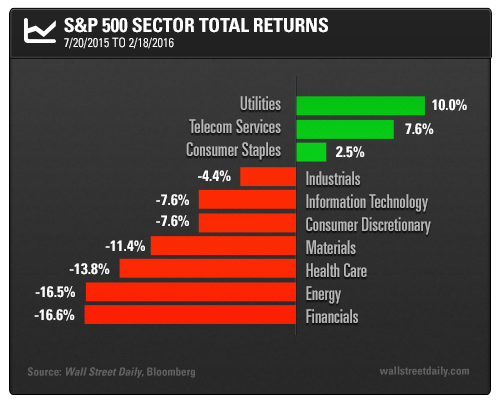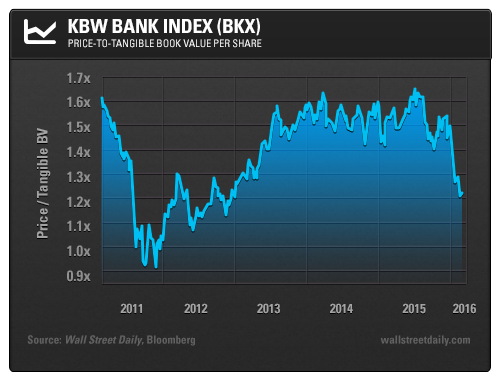The S&P 500 was last near its all-time highs in mid-July 2015. Since then, what do you think has been the worst-performing sector of the U.S. stock market?
You may have guessed the energy sector, which has continued to be pummeled due to the collapse in the price of crude oil. However, the financials have been an even bigger disaster.
As I said in October 2015, the U.S. banks are better capitalized than their global counterparts, but that didn’t mean their stocks were good investments.
The chart below ranks the S&P 500 sector total returns since July 20, 2015:

It’s not much of a surprise that the utilities, which are defensive in nature, have been the best-performing sector since the stock market swoon began.
On the other hand, the 16.6% decline for the financials is downright shocking.
Here are two of the main factors at play:
- Interest Rates: A flattening yield curve is generally bad for commercial banks. Declining long-term yields limit a bank’s opportunity to profit from lending. Also, the proliferation of negative interest rate policies (NIRP) around the world may be weighing on the minds of bank share investors.
- European Contagion: The share prices of several big European banks, such as Deutsche Bank (DE:DBKGn) and Credit Suisse (VX:CSGN), are hovering around levels last seen during the global financial crisis. Europe has a massive, non-performing loan problem. Since large, global banks are highly interconnected, the U.S. banks have fallen in sympathy.
Aside from these immediate concerns, there are general issues holding the financials back.
For example, the investment banks, such as Goldman Sachs Group (N:GS) and Morgan Stanley (N:MS), have been neutered. The Volker Rule within the Dodd-Frank Act prohibits them from engaging in proprietary trading.
The Dodd-Frank legislation has also been seen by many as making the “too big to fail” banks even larger by imposing onerous regulatory and compliance requirements on smaller banks.
Now, Neel Kashkari, the new head of the Federal Reserve Bank of Minneapolis, is publicly calling for a “transformational restructuring” of the mega-banks.
This isn’t particularly good news for the likes of Citigroup (N:C), Bank of America (N:BAC) and JP Morgan Chase (N:JPM), which are national money-center banks with investment banking arms.
Time to Buy?
On a relative basis, the financials stopped outperforming the S&P 500 around mid-2013. So, is this unloved sector now attractive given the recent underperformance?
Let’s take a look at the price-to-tangible book value for the KBW Bank Index (BKX), which includes universal banks (commercial plus investment banking) and leading regional banks, such as M&T Bank Corp (N:MTB).

The decline in bank shares over the past seven months is clearly evident to the right of the chart.
Yet, despite a sharp decline in valuation, the average bank still trades at roughly 1.2 times tangible book value. As you can see, the BKX, as a whole, traded below tangible book value in 2011.
To be sure, the banks now offer a much better risk-reward proposition than at any time in 2014 or 2015. Nonetheless, they won’t be a screaming “Buy” until they trade down to their tangible book value, in aggregate.
Most mortgage REITs, which can be considered “shadow banks,” already trade at steep discounts to their book values. Plus, they offer much juicier yields.
Safe (and high-yield) investing,
